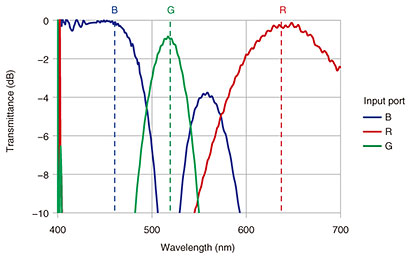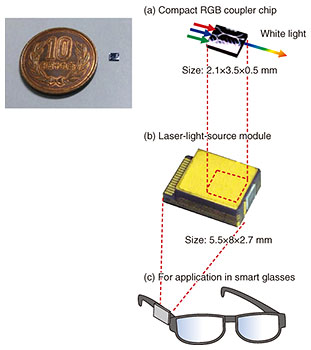 |
|||||||||||
|
|
|||||||||||
|
Feature Articles: Media Robotics as the Boundary Connecting Real Space and Cyberspace Vol. 19, No. 3, pp. 31–36, Mar. 2021. https://doi.org/10.53829/ntr202103fa6 Visible-light Planar Lightwave Circuit Technology and Integrated Laser-light-source Module for Smart GlassesAbstractNTT Device Technology Laboratories has applied planar lightwave circuit technology, which is used to integrate optical circuits on a planar substrate for optical communication devices, for use in the visible-light domain, enabling the development of dramatically smaller optical systems using all three primary colors of light (RGB: red, green, and blue). We applied this technology to an ultra-compact RGB laser-light-source module that is small enough to be installed on the temples of glasses, making smart glasses feasible. Keywords: smart glasses, visible-light planar lightwave circuits, laser-light-source module 1. IntroductionAs information and communication technology has progressed, new lifestyles are emerging like never before through information, e.g., online distribution of music and video and chat services. This information is brought to us through information terminals connected to networks. Various information terminals, such as personal computers, smartphones, and more recently, devices such as smart speakers, are being used for many daily-life situations. However, the information we receive is limited to where the terminal or other device is, and smartphones are not an exception to this. With smartphones, our access to information is possible only by peeking through a small “window” (screen). If we could develop information terminals that we could use in a more natural way, lifestyles would become richer and freer without such limitations. The optical circuit technology introduced in this article is intended for application to smart glasses, which will provide access to visual information in a more natural way, as discussed above. Smart glasses are display devices that should feel comfortable, like putting on ordinary glasses, and improve on current goggle-shaped head-mounted display devices that are being used for virtual reality, augmented reality, mixed reality, and other applications, which are generically called extended reality. Various levels of display performance are possible, but to provide an immersive experience, as with augmented reality, technology for providing high resolution and a wide field of view is necessary. Having smart glasses look like ordinary glasses requires the components to be very small, so technology is needed to achieve both optical characteristics and miniaturization. NTT Device Technology Laboratories developed the above optical circuit technology for dramatically reducing the size of optical systems that handle light in the RGB (red, green, and blue) color space. This technology is called the RGB coupler and is suitable for the type of smart glasses describe above [1, 2]. This article introduces the RGB coupler and its application to an ultra-compact RGB laser-light-source module for smart glasses. 2. Visible-light planar lightwave circuit technologyFor optical fiber communications, NTT is conducting research and development on a component technology called planar lightwave circuits (PLCs)*, in which optical circuits are integrated on a silicon substrate, similarly to electronic integrated circuits. These optical circuits are fabricated using silica glass, the same material for optical fiber, and are composed of paths several microns wide called cores. The cores have a higher refractive index than the surrounding material, causing the light to follow them (optical waveguide structures). Circuits can be built to branch, interfere with, or control the phase of the light. PLC technology is used in devices for optical fiber communications, such as optical splitters and wavelength multiplexers/demultiplexers [3] (Fig. 1). Infrared lasers with wavelengths, such as 1.55 μm, are used for optical fiber communications, so the laser technology for such wavelengths and optical circuit technology to manipulate them (e.g., wavelength multiplexers/demultiplexers) have been developed. The wavelengths of visible light are in the range of 0.4 to 0.7 μm, and since mass production of green semiconductor lasers was achieved around 2009, it has been possible to use all three primary colors. Just as visible-light light-emitting diodes came into general use over a period of more than ten years, visible-light lasers are expected to become common. When this occurs, technology to provide stable optical systems will be important for various applications using laser-light properties such as interference. NTT is applying PLC technology in the visible-light domain to develop such systems. Applications for this technology include optical light sensing and optical quantum-information processing. The RGB coupler is another application of this technology.
3. Retina-scanning laser eyewear and RGB light sourceBefore describing the RGB coupler, we first describe scanning laser eyewear. As the name suggests, laser eyewear refers to a glasses-type display device that uses laser light [4]. Laser light has the useful property of not diverging over distance, so that just like with a laser pointer, when a laser ray hits a screen it makes a clear, bright spot, regardless of the distance to the screen. By scanning this point of laser light across the screen while changing the brightness, a focused image can be displayed regardless of the distance to the screen. Scanning laser eyewear applies this principle to the human eye, using the retina as the projection screen. The crystalline lens of the human eye must change shape to form an image (focus) on the retina, but with a scanning laser, a focused image is projected on the retina regardless of the shape of the lens, so an image can be obtained regardless of visual acuity. This system is extremely simple, as shown in Fig. 2, and composed of just microelectromechanical system mirrors that scan the laser light source and another mirror that directs the laser light through the pupil. Note that the intensity of the laser is adjusted to a safe level, which is roughly 1/1000 that of a laser pointer. However, current components for such a configuration are not small enough for glasses-type laser eyewear. The laser-light-source module is a particularly complex structure, involving lenses or mirrors to combine the outputs from the three (RGB) semiconductor lasers, and is difficult to miniaturize (Fig. 2, lower left).
4. RGB coupler and RGB laser-light-source moduleNTT Device Technology Laboratories has focused on the lens and mirror structure as the optical components of the laser-light-source module described above and has significantly reduced the size of the module by applying visual-light PLC technology (Fig. 3(a)). Visible light has a short wavelength, less than half of those used for optical fiber communications, so we investigated all aspects of optical-circuit elements. We developed a new wavelength multiplexer for the RGB coupler, which has the smallest chip size yet achieved. Figures 3(b) and (c) respectively illustrate the operation of a conventional wavelength multiplexer and our new wavelength multiplexer. When two light paths (optical waveguides) are brought together, light is transferred from one waveguide to the other due to a kind of resonance, and this is called a directional coupler. The length of the directional coupler required to transfer signals through resonance depends on the wavelength, so by matching the period of the transition length, light can be combined in a single waveguide (Fig. 3(b)). At NTT, we have taken this a step further by placing a waveguide of a different width between them and found a width that simultaneously satisfies both resonant and non-resonant cases, depending on the wavelength (Fig. 3(c)). Using this configuration, we can transfer only a specific wavelength of light to the other waveguide without the need to match the period of the transition length, and light can be combined into one waveguide in a distance approximately one third of the conventional directional coupler. The light transmittance of the RGB coupler is shown in Fig. 4. The RGB wavelengths, shown in the figure with dotted lines, have high transmittance, indicating that favorable characteristics can be achieved. A chip of the RGB coupler is shown in Fig. 5(a). The chip size is 2.1×3.5×0.5 mm, and to the best of our knowledge, it is the smallest RGB coupler chip to date. NTT Device Technology Laboratories has also collaborated with TDK Corporation to implement a packaged optical light-source module (Fig. 5(b)). From this collaboration, we were able to fabricate the smallest RGB laser-light-source module (5.5×8×2.7 mm) by combining the semiconductor laser chips on subcarriers with TDK’s technology for aligning and fixing the lasers and optical waveguide ends with an accuracy of better than 1 μm in a very short time. The size of this ultra-compact RGB laser-light-source module is approximately one twentieth that of earlier RGB light-source modules using lenses or mirrors. It is comparable to the width of the temples of glasses and is suitable for implementing glasses-type laser eyewear, as shown in Fig. 5(c).
Large parts of the environment in which we live are now being produced by information. As the smartphone has had a huge influence on our lives, the technology introduced in this article will contribute to the development of display devices that can be used anywhere and much more naturally. This will contribute to creating richer environments in which to live. References
|
|||||||||||







